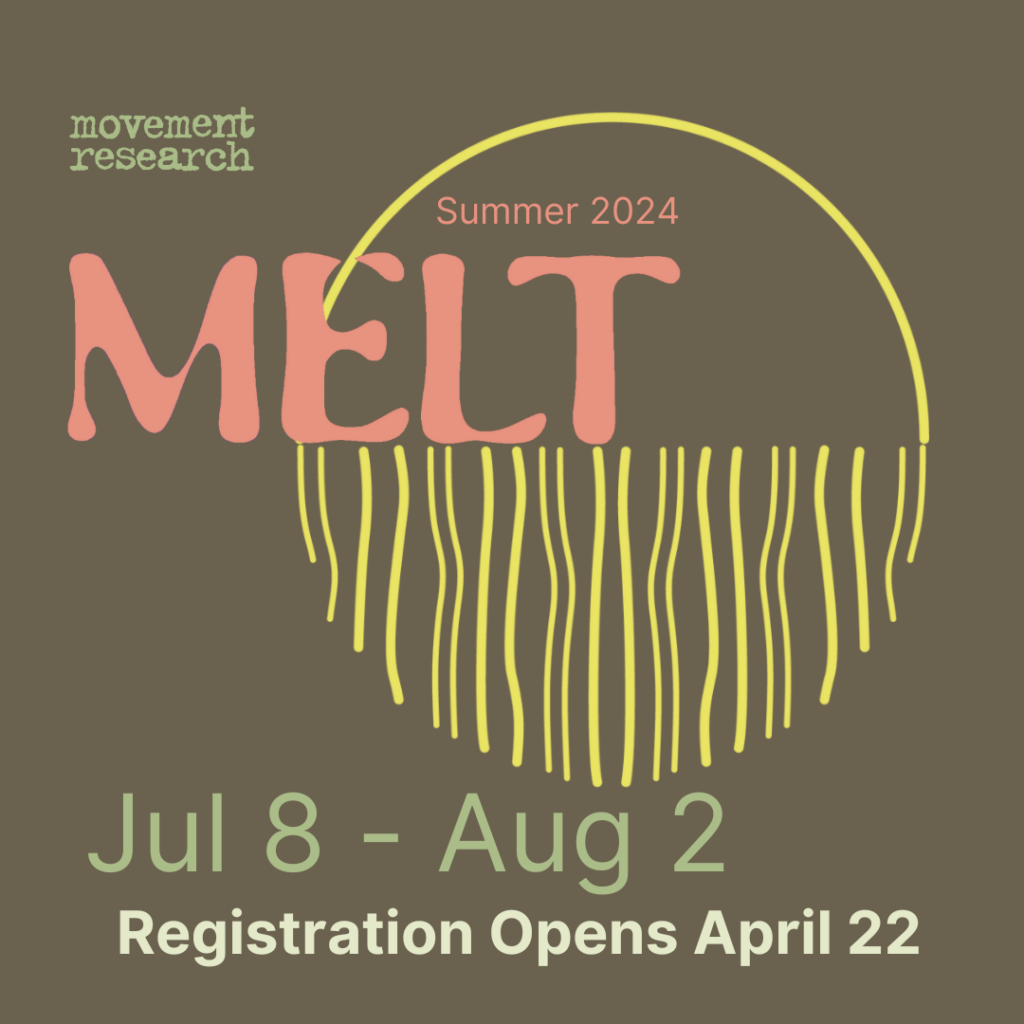CC co-editor Biba Bell shares an interlude-esque essay that expresses her ongoing project that thinks through the potential of dance to promiscuously move about, mobilize societal limitations, resist capture, and generally infiltrate disciplinary and institutional habits, aka business as usual… crashing the party; escaping the house. Woven throughout her perpetual proposition – “Would you like to dance?” – is an ongoing investigation of dance’s relation to its own domesticity, casting a new light from this line of flight.
________________________________________________________________________________________
“Would you like to dance?”
Setting the scene: scrim, backdrop, legs, wings, travelers. That instant when performance becomes “live.” What does this moment require? I’ll argue it requires the conjuring of ghosts, beckoning them to reveal themselves from within the houses of memory… archive, museum, or mausoleum. Let’s have some fun here. Listen now to Rosemarie Padovano’s Paloma (2012), whose heels flick the concrete roof/ceiling of a Greenwood Cemetery dwelling, turning its sleeping chambers into a bellowing drum. Step, step, turn, pivot, clack, clack, clack. The ghosts are shifting; the home is awaking.

Stepping onstage can feel like jumping off a cliff. It can feel like swimming head-on into a hive of bees. As the mind whirs, the voluminous theatrical house hums with invisible electricity, overtones, sonic floors, and a quiet giant that slumbers before the storm. The house, awaiting this inevitable performer, visually accentuates the silence produced by an empty stage. Suspending the actions potentially initiated by this question to dance, the historically immersive, designed to absorb, edifice stands straight and tall like the conductor of a petrified, yet orchestrated, silence.[1] Hovering in the wings or an anticipant, waiting amongst the attentive audience, we are reminded of the stillness that sits behind an action, a bevy of ghosts yet to be unleashed before the maelstrom of vibrating gazes. The price of admission to this dance is the agreement to occupy a particular space, to participate within a ritualized act of looking and place-ing bodies on display. To enter this space is to turn and face, en-face, the site (sight) of the stage… an interpellative turn (in the Althusserian sense, or better yet, Butler, as the call that is “formative, if not performative, precisely because it initiates the individual into the subjected status of the subject.”) And so, we enter, and turn towards the public or one’s partner or one’s past or one’s building desire.
“Would you like to dance?”
I turn.
Who me?
The question does something; it moves me. Cloaking a profound intimacy, it asks me to take off my hat and coat and stay awhile.
The question is asked by a disembodied voice but it conjures the image of an outstretched hand and glimmering eye. So, I rise (from repose) in order to meet my response. There is always a pause, a leap, and a moment before a recovery. That fall in or out of grace, in or out of love. The body speeds forth without revealing its direction as does the intoxicating spin of the roulette wheel. Then, suddenly, the room is filled with dancers and sweat and stank. How many hours have we been here? How many drinks have we had? The city adjusts in daylight and nightlife amongst the sounds of bodies mingling. A ritual (thank you, Richard Schechner) is also a “hardening” of practice.[2]
But does ritual necessitate, or even enable, a hardening of place? My question re-emerges alongside a strange dialogue between Jacques Derrida and Christie V. McDonald and the dancer is produced to illustrate a lucidly poetic role of resistance against the stability, surveillance, and designation of place. “The most innocent of dances would thwart the assignation à residence, escape those residences under surveillance; the dance changes place and above all changes places.”[3] The impossibility of situating this dancer à residence is another way of resisting its archive. And within this “house, a domicile, an address, the residence,” dance is thought through the mobile, elusive figure that thwarts, disrupts, escapes, and intervenes within its locale, that (again) “changes place and above all changes places.” Dance is, ultimately, a sign of life exemplar.
Whether the theater, studio, a residency sanctuary, the bedroom, restaurant, bar, or moonlit beach, this dancing figure has always already moved on to the next scene, to the future event, to the tenuous prospects of that next landing site. Where can I find the when of making work (i.e. the contemporary conditions of the choreographer)?
Perhaps we could think of choreography in relation to the voluminous vault of this ritualized space where, from the wings, one enters according to the vectors and curtains and distribution of strength and power of the stage where organizing bodies in space and time might occupy the (sight)lines of constructed geometries in conjunction with what Brian Massumi and Erin Manning call “enabling constraint(s).” From this vantage of the choreographic horizon of possibility we might think bodies dancing out the formations of soldier drills or sensual orgies, even the potted plants reaching up to fill the glorious glass walls of the greenhouse (thank you Randy Martin for this enduring, fecund image of innocently docile, “neat rows of potted dancers, fronds upward.”).[4] And, it is from this site that I have been more recently adept at imagining my dancerly dwell.
Enabling dancing… what are the chances a dancer will agree to stay in place? To change place and to, above all, change places. We move from stage to train, from photograph to film, the effect of the cinematic. Now cut, edit, transpose. Suspended in time, multiplied in space: a step, lunge, contraction, or extension moves us from the wilderness to the studio to the museum, a Study in Choreography for Camera. Imagine now Bruce Nauman’s Tony Sinking into the Floor, Face Up, and Face Down. A man lies on the floor, fifteen minutes pass. What happens? Moving in place, the ground shifts, shudders, vibrates from which the image springs.

Listen up! From seated to standing to dancing, how frequent is this action performed? How many people are making the moves, getting their moves on, at this very moment? Whether filled with elation or excruciatingly awkward, the transition requires an energy of abandon—of throwing or diving or leaping—a quick and directed choreographic act of immersion. Like the visceral impact of falling without landing, a soaring jolt of (altered) consciousness. Indistinguishable from lust, this inaugural movement marks a time before the designation of intimacy’s peaks and valleys, deserts and caves. This is a novel, inexhaustible time before maps are made, traced by the repetition of gestures, the affective rhythms of audible exhalations, or the expectant tendency to follow a wayward glance. Responding to this call to dance, Boris Charmatz exclaims, you must, inexorably, “suddenly throw yourself into matter.”[5]
“Would you like to dance?”
Martha Graham sat in her dressing room, inserting Isamu Noguchi hair ornaments into her ravenous up-do and famously states that it takes ten years to make a dancer. (From sitting to standing to dancing, ten years a dancer does make.)

From sitting to standing to dancing, again I enter the studio… the passing of decades identifies the hardening of practice. I find space on the beach, a deck, a driveway, handball or basketball courts, Veterans Memorial and Grange Halls, a garage. There are positions (in addition to first, second, or third) that succeed at harboring a well of lived experience. A posture, stance, or basic orientation is means of indexing memory. Assume the stance to crystalize the archetype. The body becomes its own landing site. Maybe there’s a window, a heater, a water fountain. Maybe there’s a musician. Maybe there’s a friend or an idol or a stranger. Maybe the room is filled with bodies; maybe it is filled with thoughts and emotions. The repeated action differs daily as does one’s relationship to a technical regime, a social atmosphere, or stamina, energy and desire, all marked by entry into a ritualized space. Even a laptop screen, a Skype session, a run, a bath, a coffee shop can provide this ritualized space. The search for dance’s sequestered place turns dancers and choreographers into nomads who momentarily set up camp (to make or rehearse a dance) as we migrate between residencies, theaters, studios, cities, countries, and continents. Thwarting its assignation à residence, this dancing (at the same time) can be a mode of finding one’s way home.
“Would you like to dance?”
For Laura Kipnis, in her essay “Adultery,” this is the quintessential question that inevitably paves the way to infidelity. Kipnis focuses on the affair as a space for rediscovering intimacy and the desire to move, and at the same time it critiques/disavows the institution of marriage predicated on property and surplus economies of labor. To enter this dance would mean to step outside of the sanctified domain of marriage, re-charting journeys toward intimacy.[6] I have less interest in how such an invitation rehearses adulterous acts between individuals and their arrangements/agreements than in how it supports a promiscuous and newly charted sense of place. I am interested in how dancing provokes transformative openings, punctures a domesticating edifice (the theater? the house?), and radically redistributes its mise en scène. This mode of dancing is of the affair. It is to step outside of the house, to cross the lawn, (during the midnight of a moonless night) and freely follow the dotted line that traces the middle of our quiet, dimly lit neighborhood street in Detroit. It is to consider the ways that bodies move through space and create they own desire paths on the daily. In conversation with Trisha Brown, Jane Crawford, Roselee Goldberg, Alanna Heiss, Lydia Yee, and the ghost of Gordon Matta-Clark, Laurie Anderson quips, “That’s the key – the floor. No stage.”[7]

Rather than staying at home, a dancer’s task is to engage the continuous movement of finding their way, of developing a keenly acute set of what Sara Ahmed localizes as “homing device” practices. “We learn what home means, or how we occupy space at home and as home, when we leave home.”[8] The very building blocks of home as a sanctified place, or as a disciplinary regime, begin to tremble and shift. (Look close and witness the fall of the house of Usher, for Robert Smithson an architectural equivalent of the studio whose crumbling liberates art from the bondage of craft and the periling snares of creativity.) To enter this mode of dancerly dwelling is to enter a trans-geo-choreography that invites bodies outside of conjugal, material confines. An adulterous relation to place, this is a diasporic dancer exceeds what Jane M. Jacob’s calls “monogamous modes of dwelling,” where, following Heidegger, dwelling involves a type of belonging to buildings, a belonging to place. One… two… three… from sitting to standing to dancing, dance’s ritualized place changes places; it multiples and becomes radically open.
“Would you like to dance?”
This question is always already a proposal, inviting us to cross the threshold into a place of promiscuous dancing. Most recently my involvement as a guest choreographer for a Dance Lab hosted by Nick Cave and his exhibition Here Hear has been the means by which to consider how dance can occupy complex, interstitial space, both in the urbanscape but also within the museum’s ritualistic standards for handling – of the art object, the body, the public. Us, sweaty, shifting, breathing, rolling, bellowing dancers enter a site often reserved for the careful caress of the white gloved caretaker. Dancing, the stakes of soil and speed, of wear and tear, have a different meaning. You never know where the lightning will strike: activist, dancerly impulses erupt in crowds of social and political unrest or amongst neighborhood games on suburban lawns; they pop up in cloistered garden parties or down the aisles of Youtube sensation wedding processions; exploratory footsteps fall to the beat at gallery openings or shuffle along through museum blockbuster exhibitions; and, libidinous rhythms cancel out traffic noise in living room theaters or sway the night away on clubroom floors. To respond to the force of this time- and place-less call is to dance a joyful seduction.







